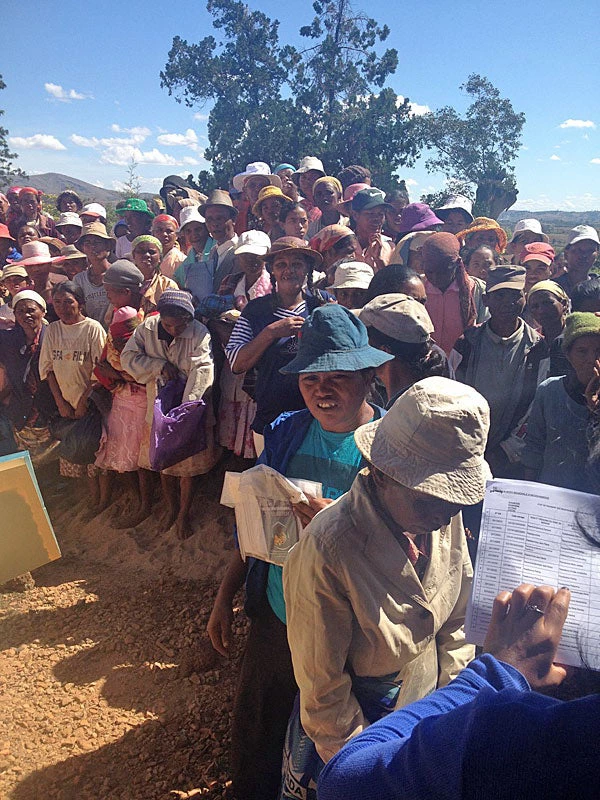
It is 8 AM. The winter sun begins to appear over the gray-green mass of trees above the village of Tritriva in Madagascar’s central highlands. The courtyard of a stone church is already filled with women, many holding still-sleeping children in their arms. They have assembled for the first time in two months to receive a cash payment from the Malagasy state.
The women are poor and all live on less than $2 per day. The money they receive from the government amounts to about a third of their cash income for the two months in between each payment: it will go a long way in helping them support their families for the rest of the winter.
Initiated by the Madagascar government, with support from the World Bank, the payments are part of a new program implemented by the Fonds d'Intervention pour le Développement (FID) to combat poverty in rural Madagascar and provide sustainable pathways to human development.
Vatsin'ankohonana (“family support”)—known in English as the Human Development Cash Transfer program (HDCT)—seeks to improve the living conditions of extremely poor families. For families with children aged 6-10, cash transfers are linked to maintaining regular school attendance. For families with children aged 0-5, support is unconditional. However, improvements in family health and nutrition practices, early childhood development and parenting feature prominently in accompanying trainings and informational aids.
School attendance has dropped precipitously in rural Madagascar in recent years, with the deepening of simultaneous political, economic, and environmental crises. Yet, in Betafo, the locality where the cash transfer program is being piloted with 5,600 beneficiary families, early results suggest that classroom attendance for school-age children has jumped to 98.5%.
Though impressive, this may not be surprising when considering that school attendance is a mandatory condition for receiving the HDCT income support (although in some other countries, uptake has been less enthusiastic). But what about attitudes on nutrition, health practices, parenting, and early childhood development activities for which no “hard” requirement exists?
Behavior change is complicated and requires a nuanced appreciation of the context in which people make decisions and take actions. For rural Malagasy women to adopt new behaviors in their households, simply learning about them in a workshop or training session is unlikely to be enough. These behaviors must become part of well-established routines and habits. They must connect in some way to their vision of themselves and their families’ futures.
Poverty makes adoption of these behaviors particularly difficult. Recent advances in behavioral science have demonstrated that cognitive “bandwidth” is a scarce resource, much like physical, social or economic resources that must be deliberately allocated as part of daily life.
Living in a state of constant need places huge demands on these cognitive resources, straining an individual’s ability to look for alternatives when making a decision, set concrete goals for themselves, or fight back against temptation. Poverty exacerbates the psychological biases that all humans face, making it that much harder for the poor to take the decisions and actions to build capital of all types: financial, human, social, or intangible. Unfortunately, this psychology of poverty plays a big part in keeping communities and households in poverty.
Solutions do exist. By examining the context of poor peoples’ lives, program designers can try to minimize factors that cause cognitive “scarcity” and emphasize those that promote active decision-making and action-taking. Behavioral “nudges” such as these can take the form of helpful and well-timed reminders, plan-making exercises, or simply “framing” a program’s objectives for beneficiaries so that the cash transfers and their objectives are closely linked in their minds.
A number of such interventions are planned for Madagascar’s HDCT program. For example, to make it easier to resist suboptimal spending at the market (e.g. just buying more rice with the additional money), planning exercises are carried out to help beneficiaries set goals and articulate concrete actions to meet them through games and group discussions.
In one of the ‘nudge’ interventions, beneficiary mothers select stickers with pictures of nutritious foods available in local markets, discuss prioritizing purchases and bring the stickers home to remind them of their intentions. In another exercise, laminated “good parenting” image cards are selected by beneficiaries and used to foster discussions about child development, helping mothers re-affirm their role as parents.

Another innovation—imported from a similar program in Colombia—is the election of Reny Mavitska, or “Mother Leaders.” These are women elected among the beneficiaries to serve as leaders, facilitators and catalyzers of a small group of beneficiaries. Trained extensively in parenting, child health practices and citizen engagement, Mother Leaders assume a large share of the responsibility to encourage and monitor adoption of promotional behaviors within their communities.
Building on the Betafo pilot’s success, the government plans are to scale up the HDCT program to more than 39,000 families in six districts of Madagascar in 2016. The Malagasy government—represented by the FID and the Ministry of Population, Social Protection, and Promotion of Women which oversees the social protection sector—has many implementing partners including the National Nutrition Office and the Ministry of Education (to promote participation in their services), UNICEF, in advising on essential family practices for the Mother Leaders, and ideas42, which is designing the behavioral interventions and a rigorous impact evaluation in collaboration with the government and the World Bank for the program’s extension.
Back in Tritrivia, where we began, about 800 women wait with palpable excitement. The sun rises in the sky—it is now almost noon—and their turn to receive the cash has finally come. They approach a shaded desk manned by employees of a local mobile payment agency who verify beneficiaries’ identities and disburse several bills. Grins widen as mothers carefully place the cash into woven handbags and depart for home. They will return in another two months, with new financial needs, new plans for how to spend the cash, and new hopes for the future.
For more information about safety nets, read the State of Safety Nets 2015 report.
Check out this infographic on Safety Nets for quick facts.
Follow the World Bank Social Protection and Labor team on Twitter .




Join the Conversation